专题八:非谓语动词【2024高分攻略】高考英语二轮专题复习 课件
文档属性
| 名称 | 专题八:非谓语动词【2024高分攻略】高考英语二轮专题复习 课件 |  | |
| 格式 | ppt | ||
| 文件大小 | 1.7MB | ||
| 资源类型 | 试卷 | ||
| 版本资源 | 通用版 | ||
| 科目 | 英语 | ||
| 更新时间 | 2023-12-22 16:10:13 | ||
图片预览

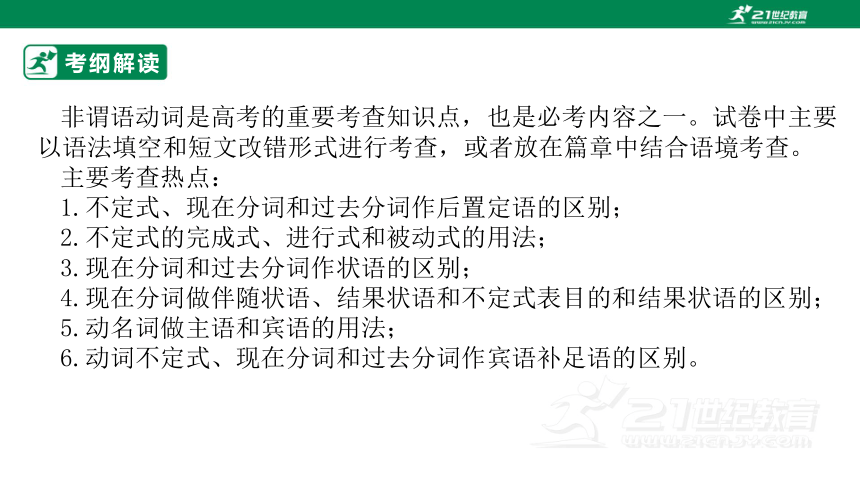
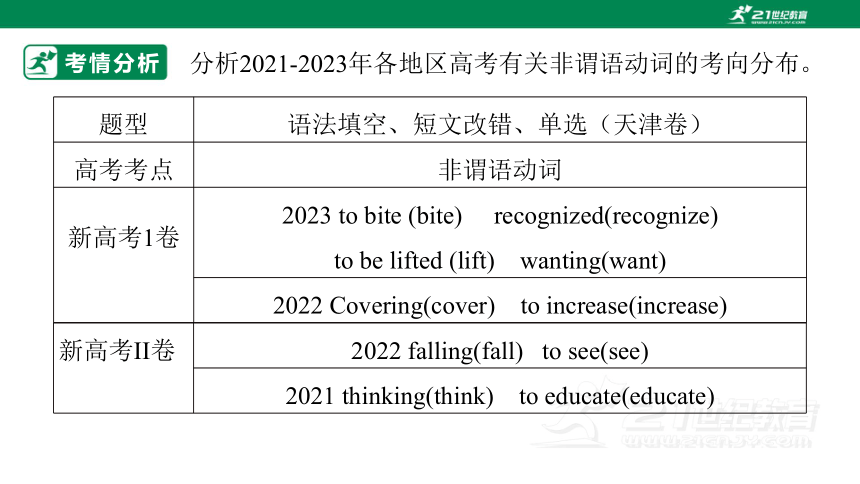
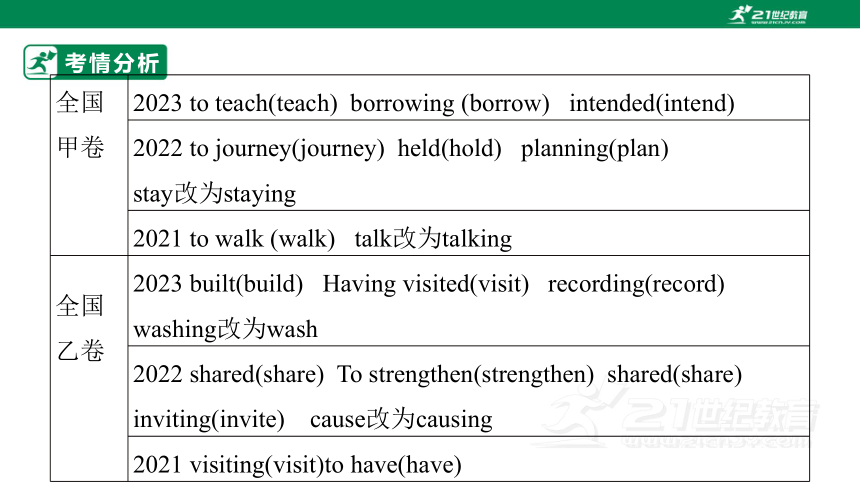
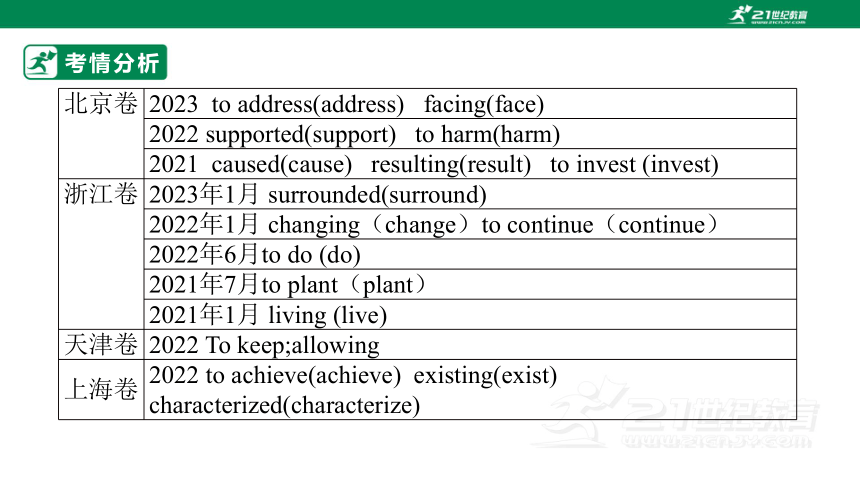

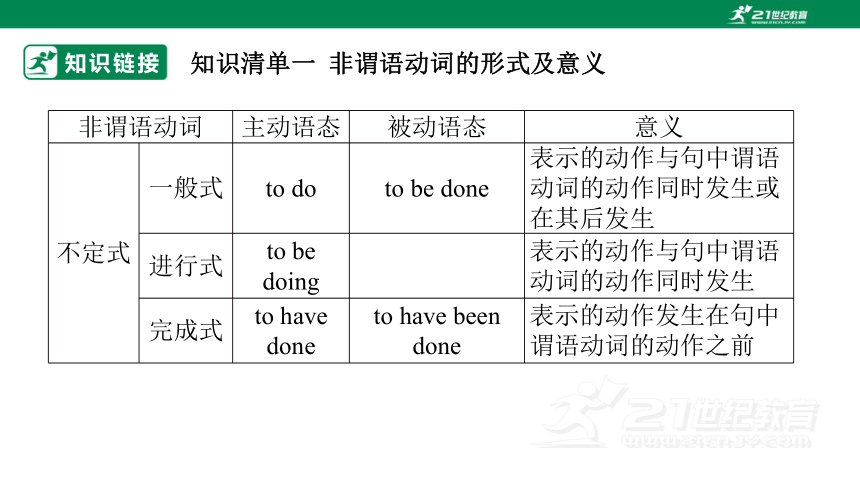
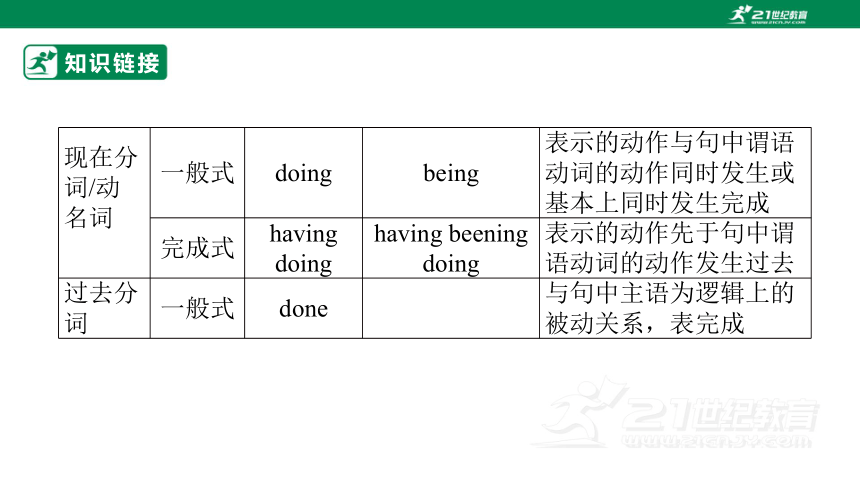
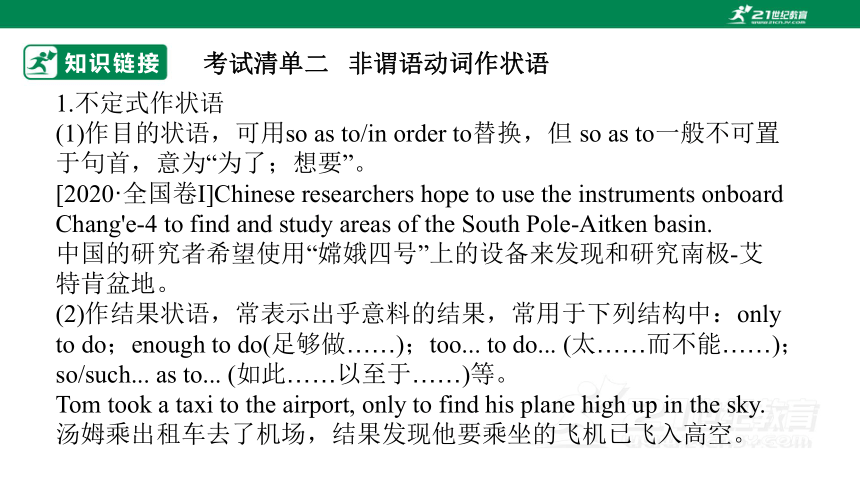
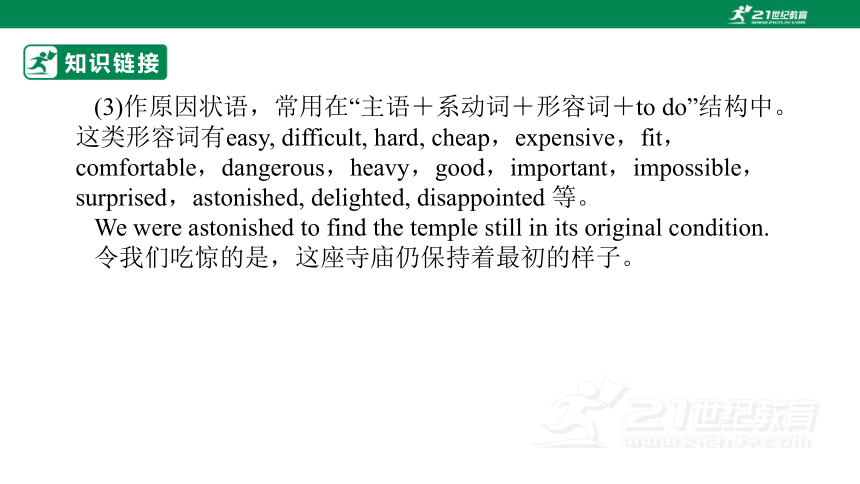

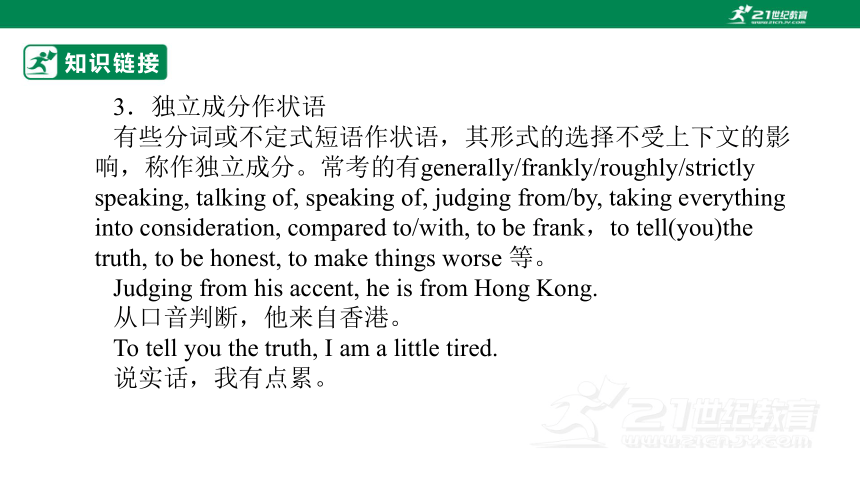
文档简介
(共35张PPT)
高考英语二轮复习(通用版)
非谓语动词
考纲解读
非谓语动词是高考的重要考查知识点,也是必考内容之一。试卷中主要以语法填空和短文改错形式进行考查,或者放在篇章中结合语境考查。
主要考查热点:
1.不定式、现在分词和过去分词作后置定语的区别;
2.不定式的完成式、进行式和被动式的用法;
3.现在分词和过去分词作状语的区别;
4.现在分词做伴随状语、结果状语和不定式表目的和结果状语的区别;
5.动名词做主语和宾语的用法;
6.动词不定式、现在分词和过去分词作宾语补足语的区别。
考情分析
分析2021-2023年各地区高考有关非谓语动词的考向分布。
题型 语法填空、短文改错、单选(天津卷)
高考考点 非谓语动词
新高考1卷
2023 to bite (bite) recognized(recognize)
to be lifted (lift) wanting(want)
2022 Covering(cover) to increase(increase)
新高考II卷
2022 falling(fall) to see(see)
2021 thinking(think) to educate(educate)
考情分析
全国甲卷
2023 to teach(teach) borrowing (borrow) intended(intend)
2022 to journey(journey) held(hold) planning(plan)
stay改为staying
2021 to walk (walk) talk改为talking
全国乙卷
2023 built(build) Having visited(visit) recording(record) washing改为wash
2022 shared(share) To strengthen(strengthen) shared(share) inviting(invite) cause改为causing
2021 visiting(visit)to have(have)
考情分析
北京卷
2023 to address(address) facing(face)
2022 supported(support) to harm(harm)
2021 caused(cause) resulting(result) to invest (invest)
浙江卷
2023年1月 surrounded(surround)
2022年1月 changing(change)to continue(continue)
2022年6月to do (do)
2021年7月to plant(plant)
2021年1月 living (live)
天津卷 2022 To keep;allowing
上海卷 2022 to achieve(achieve) existing(exist) characterized(characterize)
考情分析
知识链接
知识清单一 非谓语动词的形式及意义
非谓语动词 主动语态 被动语态 意义
不定式 一般式 to do to be done 表示的动作与句中谓语动词的动作同时发生或在其后发生
进行式 to be doing 表示的动作与句中谓语动词的动作同时发生
完成式 to have done to have been done 表示的动作发生在句中谓语动词的动作之前
知识链接
现在分词/动名词
一般式 doing being 表示的动作与句中谓语动词的动作同时发生或基本上同时发生完成
完成式 having doing having beening doing 表示的动作先于句中谓语动词的动作发生过去
过去分词 一般式 done 与句中主语为逻辑上的被动关系,表完成
知识链接
1.不定式作状语
(1)作目的状语,可用so as to/in order to替换,但 so as to一般不可置于句首,意为“为了;想要”。
[2020·全国卷Ⅰ]Chinese researchers hope to use the instruments onboard Chang'e-4 to find and study areas of the South Pole-Aitken basin.
中国的研究者希望使用“嫦娥四号”上的设备来发现和研究南极-艾特肯盆地。
(2)作结果状语,常表示出乎意料的结果,常用于下列结构中:only to do;enough to do(足够做……);too... to do... (太……而不能……);so/such... as to... (如此……以至于……)等。
Tom took a taxi to the airport, only to find his plane high up in the sky.
汤姆乘出租车去了机场,结果发现他要乘坐的飞机已飞入高空。
考试清单二 非谓语动词作状语
知识链接
(3)作原因状语,常用在“主语+系动词+形容词+to do”结构中。这类形容词有easy, difficult, hard, cheap,expensive,fit,comfortable,dangerous,heavy,good,important,impossible,surprised,astonished, delighted, disappointed 等。
We were astonished to find the temple still in its original condition.
令我们吃惊的是,这座寺庙仍保持着最初的样子。
知识链接
2.分词作状语
现在分词作状语时,现在分词所表示的动作与句子主语之间构成逻辑上的主动关系。过去分词作状语时,过去分词所表示的动作与句子主语之间构成逻辑上的被动关系。
[2020·江苏卷]Technological innovations, combined with good marketing, will promote the sales of these products.
知识链接
3.独立成分作状语
有些分词或不定式短语作状语,其形式的选择不受上下文的影响,称作独立成分。常考的有generally/frankly/roughly/strictly speaking, talking of, speaking of, judging from/by, taking everything into consideration, compared to/with, to be frank,to tell(you)the truth, to be honest, to make things worse 等。
Judging from his accent, he is from Hong Kong.
从口音判断,他来自香港。
To tell you the truth, I am a little tired.
说实话,我有点累。
知识链接
4.独立主格结构
非谓语动词作状语时,它的逻辑主语应和句子主语保持一致。但有时非谓语动词带有自己的逻辑主语,在句子中作状语,我们称之为独立主格结构。
(1)独立主格结构的特点:①独立主格结构的逻辑主语与句子的主语不同,它独立存在。②独立主格结构中作逻辑主语的名词或代词与后面的分词或不定式是逻辑上的主动或被动关系。③独立主格结构一般用逗号与句子分开。
知识链接
(2)独立主格结构的常见构成:①名词/代词+分词;②名词/代词+不定式;③with/without+名词/代词+分词/不定式。
Weather permitting, we shall play the match tomorrow.
明天如果天气好,我们就进行比赛。
The test finished(=When the test was finished),we began our holiday.
考试结束后,我们就开始放假了。
知识链接
1.不定式作定语
(1)不定式作定语通常放在所修饰词之后,表示将来的动作。不定式与其所修饰的词之间往往是动宾关系,若该不定式是不及物动词,其后应有必要的介词。
Suddenly a good idea occurred to her,but she couldn't find any paper to write on.
突然她想到了一个好主意,但是她找不到纸把它写下来。
(2)序数词,形容词最高级,the last, the only 等后或被这些词修饰的名词/代词后,常用不定式作定语。
He is always the first to arrive at the school and the last to leave the school.
他总是第一个到校,最后一个离校。
考试清单三 非谓语动词作定语
知识链接
(3)被修饰词是抽象名词时,常用不定式作定语。常见名词:ability, chance, idea, hope, wish, fact, excuse, promise, attempt, way 等。
And the best way to strengthen willpower is to make it into a habit.
增强意志力最好的方法就是让意志力成为一种习惯。
The ability to express an idea is as important as the idea itself.
表达观点的能力与观点本身同等重要。
知识链接
2.分词作定语
(1)作定语的及物动词的分词形式:现在分词、being+过去分词、过去分词。当被修饰的名词与分词之间为主动关系时,用现在分词;当被修饰的名词与分词之间为被动关系且表示正在进行时,用being+过去分词;当被修饰的名词与分词之间为被动关系且表示完成时,用过去分词。
(2)作定语的不及物动词的分词形式:现在分词和过去分词。现在分词表示动作正在进行;过去分词只表示动作已完成,不表示被动。
[2021·浙江卷1月]In 1985,urban men and women in more than three quarters of the countries studied had higher BMIs than men and women in rural areas.
1985年,在被研究的国家中,超过四分之三的城市男性和女性的BMIs高于农村地区的男性和女性。
知识链接
1.只接不定式作宾语的动词:
agree, plan, demand, promise, prepare, decide, refuse, choose, wish, hope, expect, fail (未能), pretend, manage, determine, beg, arrange, threaten, claim, hesitate, wait, happen (碰巧)等。
[2021·全国乙卷]Activities there range from whale watching to hiking(远足)and accommodations aim to have a low impact on the natural environment.
这里的活动从观鲸到徒步旅行并且住宿宗旨是对自然环境影响达到很小。
考试清单四 非谓语动词作宾语
知识链接
2.只接动名词作宾语的动词及短语:
admit, avoid, consider, escape(避开), imagine, mind, miss, practise, suggest, feel like, give up, put off, object to, look forward to等。此外,have difficulty/trouble (in) doing sth. ;have fun (in) doing sth. 等结构中也用动名词作宾语。
I avoided mentioning the subject in case he should be offended.
我避免提及这个话题,以免冒犯他。
It's quite hot today. Do you feel like going for a swim
今天很热。你想去游泳吗?
知识链接
3.接不定式与动名词作宾语意义不同的动词:
知识链接
1.不定式作宾补
不定式作宾补时,宾语和不定式之间在逻辑上是主谓关系,不定式表示将要发出的主动动作。常接不定式作宾补的动词(短语):advise, allow, ask, beg, cause, encourage, expect, forbid, force, intend, invite, order, persuade, prefer, require, remind, tell, want, warn, wish, call on, depend on等。
If we expect people to give up the habit of driving,we must give them an alternative they can rely on.
如果我们期望人们放弃开车的习惯,我们必须给他们可以依赖的选择。
Having finished her project, she was invited by the school to speak to the new students.
完成项目之后,她被学校邀请去给新生讲话。
考试清单五 非谓语动词作宾补
知识链接
(1)有些动词,如think, consider, believe, suppose, feel, find, understand等后常用to be作宾补或主补。
Chinese people are considered to be the most hard-working people in the world.
中国人被认为是世界上最勤劳的人民。
(2)在sb. be said/believed/known/reported/considered/thought+to do/to have done结构中,不定式用作主语补足语。
The president was reported to have visited China.
据报道,那位总统已经访问了中国。
知识链接
2.分词作宾补
(1)现在分词作宾补时,动词与宾语之间存在逻辑上的主谓关系,且强调正在进行的主动动作。可接现在分词作宾补的常见动词:感官动词(see, watch, observe, notice, hear, listen, feel),使役动词(have, get), find, leave, keep, catch等。
Listen! Do you hear someone calling for help
听!你听到有人正在呼喊救命吗?
(2)过去分词作宾补时,动词与宾语之间存在逻辑上的动宾关系,且表示被动动作。可接过去分词作宾补的常见动词:感官动词(see, watch, observe, notice, hear, listen, feel),使役动词(have, make, let, get), find, leave, keep等。
He found himself surrounded by so many strangers.
他发现自己周围有那么多陌生人。
知识链接
(3)使役动词have, get后接非谓语动词作补语的异同点:
①have sth. done=get sth. done让别人做某事;
②have sb./sth. doing让……一直做某事;
get sth./sb. doing 使……开始做某事;
③have sb. do sth. =get sb. to do sth. 让某人做某事。
Before driving into the city, you are required to get your car washed.
在开车进城之前,你需要洗洗车。
知识链接
【重难点提醒】(4)with的复合结构:①with+宾语+doing表示主动,说明动作正在发生或经常发生;②with+宾语+done表示被动或完成;③with+宾语+to do表示将要发生的动作。
The old couple often take a walk after supper in the park with their pet dog following them.
这老两口常常在晚饭后到公园里散步,他们的宠物狗则在后面跟着。
With such a short time left before the deadline, it doesn't seem likely that John will finish the job.
截止日期之前只剩下很短的时间,约翰似乎不可能完成工作了。
With a lot of work to do, she wasn't allowed to leave her office.
由于有许多工作要做,她不被允许离开办公室。
知识链接
1.不定式作主语和表语
(1)不定式作主语时,一般表示具体某一次的动作。若不定式太长,常用it作形式主语而将不定式后置。
[2021·全国甲卷]It is possible to walk or bike the entire 14 kilometers.
步行或骑行这完整的14千米是可能的。
(2)不定式作表语时:①表示预定要发生的动作;②当主语是aim, purpose, idea, plan, wish, decision, choice等词时,常用不定式作表语;③主语为what引导的名词性从句时,表语多用不定式。
His wish is to be a doctor in the future.
他的愿望是将来当一名医生。
What I want to do most in senior high school is to improve my English.
我在高中最想做的事就是提高我的英语水平。
考试清单六 非谓语动词作主语和表语
知识链接
2.动名词作主语和表语
(1)动名词作主语常表示抽象的、泛指的概念,也可用it作形式主语,把作真正主语的动名词短语放在句末。常用于固定句型:It's a waste of time doing...; It's no use/good doing...; It is useless doing...; There is no point doing... 等。
Facing up to your problems rather than running away from them is the best approach to working things out.
直面你的问题而不是逃避它们,是解决这些问题最好的方法。
It's no use complaining without taking action.
不采取行动而只是抱怨是没用的。
知识链接
(2)动名词作表语时相当于名词,用于解释主语的内容,表语和主语常常可以互换位置。
My job is cleaning the house three times a week.=Cleaning the house three times a week is my job.
我的工作是每星期打扫三次房子。
(3)remain作系动词时,意为“仍然是”时,后可接现在分词或过去分词作表语;但作不及物动词时,意为“尚待……;留待……”时,后常接to be done。
She remained standing though we repeatedly asked her to sit down.
虽然我们三番五次地请她坐下,但她还是站着。
It remains to be seen whether the newly-formed committee's policy can be put into practice.
新成立的委员会提出的方针能否实行还有待观察。
知识链接
1.首先辨别谓语动词和非谓语动词【语法填空中的关键问题】
(1)一个句子无论是主句还是从句,必须要有谓语,一般空格所在的句子中无其他动词,则填谓语动词。谓语动词要考虑时态、语态和主谓一致等。
(2)若句中找到了谓语动词,而又找不到连词(并列连词或从句连词)时,则所给动词一定用非谓语动词。非谓语动词需要确定是动词-ing形式、动词-ed形式还是动词不定式形式。
2.结合语境,判断设空处在句子中作的成分,然后分析动词与逻辑主语或被修饰词等之间的关系,从而确定非谓语的形式。
3.掌握doing作宾语的动词(词组)的用法,注意介词后要跟doing作宾语。
考试清单七 非谓语动词考点的解题关键
知识链接
4.若非谓语动词与逻辑主语之间是被动关系,且表示完成,要想到用动词-ed形式。
5.若非谓语动词表示将来的动作,作状语表示目的,在喜怒哀乐的形容词后作原因或意料之外的结果等,要想到用动词不定式形式。
6.掌握非谓语动词的句型
It's+形容词+(for/of sb+) to do sth;find/think/believe/consider+it+形容词+to do sth。
易错失分项
1.部分过去分词作状语时不表示被动,也不表示完成,而表示一种状态。常见的:located (坐落于), lost(迷路的), seated(坐着的), hidden(躲着的), lost/absorbed/buried in(沉溺于), dressed in(穿着), tired of(厌烦的), faced with(面对着)。
易错失分项
2.表示被动、完成用过去分词(done);表示主动、进行用现在分词(doing);表示被动、进行用being done;表示主动、尚未进行用to do;表示被动的动作尚未进行用to be done。试比较:
①The bridge built recently was designed by a local company.
②Today there are more airplanes carrying more people than ever before in the sky.
③The bridge being built now was designed by a local company.
④The question to be discussed at tomorrow's meeting is very important.
易错失分项
3. (1)动词want, need, require作“需要”讲时,其后要用v.-ing形式的主动形式或不定式的被动形式作宾语。与此用法相同的动词还有deserve(值得)。
(2)不定式作动词(短语)learn, decide, know, wonder, show, tell, understand, explain, teach, advise, find out 等的宾语时,前面常带引导词how, what, whether, where, when, who等。
(3)介词后一般要接v.-ing形式作宾语,但介词but/except后接不定式作宾语时,若前有实义动词do,不定式要省略to。
谢谢
21世纪教育网(www.21cnjy.com)
中小学教育资源网站
兼职招聘:
https://www.21cnjy.com/recruitment/home/admin
高考英语二轮复习(通用版)
非谓语动词
考纲解读
非谓语动词是高考的重要考查知识点,也是必考内容之一。试卷中主要以语法填空和短文改错形式进行考查,或者放在篇章中结合语境考查。
主要考查热点:
1.不定式、现在分词和过去分词作后置定语的区别;
2.不定式的完成式、进行式和被动式的用法;
3.现在分词和过去分词作状语的区别;
4.现在分词做伴随状语、结果状语和不定式表目的和结果状语的区别;
5.动名词做主语和宾语的用法;
6.动词不定式、现在分词和过去分词作宾语补足语的区别。
考情分析
分析2021-2023年各地区高考有关非谓语动词的考向分布。
题型 语法填空、短文改错、单选(天津卷)
高考考点 非谓语动词
新高考1卷
2023 to bite (bite) recognized(recognize)
to be lifted (lift) wanting(want)
2022 Covering(cover) to increase(increase)
新高考II卷
2022 falling(fall) to see(see)
2021 thinking(think) to educate(educate)
考情分析
全国甲卷
2023 to teach(teach) borrowing (borrow) intended(intend)
2022 to journey(journey) held(hold) planning(plan)
stay改为staying
2021 to walk (walk) talk改为talking
全国乙卷
2023 built(build) Having visited(visit) recording(record) washing改为wash
2022 shared(share) To strengthen(strengthen) shared(share) inviting(invite) cause改为causing
2021 visiting(visit)to have(have)
考情分析
北京卷
2023 to address(address) facing(face)
2022 supported(support) to harm(harm)
2021 caused(cause) resulting(result) to invest (invest)
浙江卷
2023年1月 surrounded(surround)
2022年1月 changing(change)to continue(continue)
2022年6月to do (do)
2021年7月to plant(plant)
2021年1月 living (live)
天津卷 2022 To keep;allowing
上海卷 2022 to achieve(achieve) existing(exist) characterized(characterize)
考情分析
知识链接
知识清单一 非谓语动词的形式及意义
非谓语动词 主动语态 被动语态 意义
不定式 一般式 to do to be done 表示的动作与句中谓语动词的动作同时发生或在其后发生
进行式 to be doing 表示的动作与句中谓语动词的动作同时发生
完成式 to have done to have been done 表示的动作发生在句中谓语动词的动作之前
知识链接
现在分词/动名词
一般式 doing being 表示的动作与句中谓语动词的动作同时发生或基本上同时发生完成
完成式 having doing having beening doing 表示的动作先于句中谓语动词的动作发生过去
过去分词 一般式 done 与句中主语为逻辑上的被动关系,表完成
知识链接
1.不定式作状语
(1)作目的状语,可用so as to/in order to替换,但 so as to一般不可置于句首,意为“为了;想要”。
[2020·全国卷Ⅰ]Chinese researchers hope to use the instruments onboard Chang'e-4 to find and study areas of the South Pole-Aitken basin.
中国的研究者希望使用“嫦娥四号”上的设备来发现和研究南极-艾特肯盆地。
(2)作结果状语,常表示出乎意料的结果,常用于下列结构中:only to do;enough to do(足够做……);too... to do... (太……而不能……);so/such... as to... (如此……以至于……)等。
Tom took a taxi to the airport, only to find his plane high up in the sky.
汤姆乘出租车去了机场,结果发现他要乘坐的飞机已飞入高空。
考试清单二 非谓语动词作状语
知识链接
(3)作原因状语,常用在“主语+系动词+形容词+to do”结构中。这类形容词有easy, difficult, hard, cheap,expensive,fit,comfortable,dangerous,heavy,good,important,impossible,surprised,astonished, delighted, disappointed 等。
We were astonished to find the temple still in its original condition.
令我们吃惊的是,这座寺庙仍保持着最初的样子。
知识链接
2.分词作状语
现在分词作状语时,现在分词所表示的动作与句子主语之间构成逻辑上的主动关系。过去分词作状语时,过去分词所表示的动作与句子主语之间构成逻辑上的被动关系。
[2020·江苏卷]Technological innovations, combined with good marketing, will promote the sales of these products.
知识链接
3.独立成分作状语
有些分词或不定式短语作状语,其形式的选择不受上下文的影响,称作独立成分。常考的有generally/frankly/roughly/strictly speaking, talking of, speaking of, judging from/by, taking everything into consideration, compared to/with, to be frank,to tell(you)the truth, to be honest, to make things worse 等。
Judging from his accent, he is from Hong Kong.
从口音判断,他来自香港。
To tell you the truth, I am a little tired.
说实话,我有点累。
知识链接
4.独立主格结构
非谓语动词作状语时,它的逻辑主语应和句子主语保持一致。但有时非谓语动词带有自己的逻辑主语,在句子中作状语,我们称之为独立主格结构。
(1)独立主格结构的特点:①独立主格结构的逻辑主语与句子的主语不同,它独立存在。②独立主格结构中作逻辑主语的名词或代词与后面的分词或不定式是逻辑上的主动或被动关系。③独立主格结构一般用逗号与句子分开。
知识链接
(2)独立主格结构的常见构成:①名词/代词+分词;②名词/代词+不定式;③with/without+名词/代词+分词/不定式。
Weather permitting, we shall play the match tomorrow.
明天如果天气好,我们就进行比赛。
The test finished(=When the test was finished),we began our holiday.
考试结束后,我们就开始放假了。
知识链接
1.不定式作定语
(1)不定式作定语通常放在所修饰词之后,表示将来的动作。不定式与其所修饰的词之间往往是动宾关系,若该不定式是不及物动词,其后应有必要的介词。
Suddenly a good idea occurred to her,but she couldn't find any paper to write on.
突然她想到了一个好主意,但是她找不到纸把它写下来。
(2)序数词,形容词最高级,the last, the only 等后或被这些词修饰的名词/代词后,常用不定式作定语。
He is always the first to arrive at the school and the last to leave the school.
他总是第一个到校,最后一个离校。
考试清单三 非谓语动词作定语
知识链接
(3)被修饰词是抽象名词时,常用不定式作定语。常见名词:ability, chance, idea, hope, wish, fact, excuse, promise, attempt, way 等。
And the best way to strengthen willpower is to make it into a habit.
增强意志力最好的方法就是让意志力成为一种习惯。
The ability to express an idea is as important as the idea itself.
表达观点的能力与观点本身同等重要。
知识链接
2.分词作定语
(1)作定语的及物动词的分词形式:现在分词、being+过去分词、过去分词。当被修饰的名词与分词之间为主动关系时,用现在分词;当被修饰的名词与分词之间为被动关系且表示正在进行时,用being+过去分词;当被修饰的名词与分词之间为被动关系且表示完成时,用过去分词。
(2)作定语的不及物动词的分词形式:现在分词和过去分词。现在分词表示动作正在进行;过去分词只表示动作已完成,不表示被动。
[2021·浙江卷1月]In 1985,urban men and women in more than three quarters of the countries studied had higher BMIs than men and women in rural areas.
1985年,在被研究的国家中,超过四分之三的城市男性和女性的BMIs高于农村地区的男性和女性。
知识链接
1.只接不定式作宾语的动词:
agree, plan, demand, promise, prepare, decide, refuse, choose, wish, hope, expect, fail (未能), pretend, manage, determine, beg, arrange, threaten, claim, hesitate, wait, happen (碰巧)等。
[2021·全国乙卷]Activities there range from whale watching to hiking(远足)and accommodations aim to have a low impact on the natural environment.
这里的活动从观鲸到徒步旅行并且住宿宗旨是对自然环境影响达到很小。
考试清单四 非谓语动词作宾语
知识链接
2.只接动名词作宾语的动词及短语:
admit, avoid, consider, escape(避开), imagine, mind, miss, practise, suggest, feel like, give up, put off, object to, look forward to等。此外,have difficulty/trouble (in) doing sth. ;have fun (in) doing sth. 等结构中也用动名词作宾语。
I avoided mentioning the subject in case he should be offended.
我避免提及这个话题,以免冒犯他。
It's quite hot today. Do you feel like going for a swim
今天很热。你想去游泳吗?
知识链接
3.接不定式与动名词作宾语意义不同的动词:
知识链接
1.不定式作宾补
不定式作宾补时,宾语和不定式之间在逻辑上是主谓关系,不定式表示将要发出的主动动作。常接不定式作宾补的动词(短语):advise, allow, ask, beg, cause, encourage, expect, forbid, force, intend, invite, order, persuade, prefer, require, remind, tell, want, warn, wish, call on, depend on等。
If we expect people to give up the habit of driving,we must give them an alternative they can rely on.
如果我们期望人们放弃开车的习惯,我们必须给他们可以依赖的选择。
Having finished her project, she was invited by the school to speak to the new students.
完成项目之后,她被学校邀请去给新生讲话。
考试清单五 非谓语动词作宾补
知识链接
(1)有些动词,如think, consider, believe, suppose, feel, find, understand等后常用to be作宾补或主补。
Chinese people are considered to be the most hard-working people in the world.
中国人被认为是世界上最勤劳的人民。
(2)在sb. be said/believed/known/reported/considered/thought+to do/to have done结构中,不定式用作主语补足语。
The president was reported to have visited China.
据报道,那位总统已经访问了中国。
知识链接
2.分词作宾补
(1)现在分词作宾补时,动词与宾语之间存在逻辑上的主谓关系,且强调正在进行的主动动作。可接现在分词作宾补的常见动词:感官动词(see, watch, observe, notice, hear, listen, feel),使役动词(have, get), find, leave, keep, catch等。
Listen! Do you hear someone calling for help
听!你听到有人正在呼喊救命吗?
(2)过去分词作宾补时,动词与宾语之间存在逻辑上的动宾关系,且表示被动动作。可接过去分词作宾补的常见动词:感官动词(see, watch, observe, notice, hear, listen, feel),使役动词(have, make, let, get), find, leave, keep等。
He found himself surrounded by so many strangers.
他发现自己周围有那么多陌生人。
知识链接
(3)使役动词have, get后接非谓语动词作补语的异同点:
①have sth. done=get sth. done让别人做某事;
②have sb./sth. doing让……一直做某事;
get sth./sb. doing 使……开始做某事;
③have sb. do sth. =get sb. to do sth. 让某人做某事。
Before driving into the city, you are required to get your car washed.
在开车进城之前,你需要洗洗车。
知识链接
【重难点提醒】(4)with的复合结构:①with+宾语+doing表示主动,说明动作正在发生或经常发生;②with+宾语+done表示被动或完成;③with+宾语+to do表示将要发生的动作。
The old couple often take a walk after supper in the park with their pet dog following them.
这老两口常常在晚饭后到公园里散步,他们的宠物狗则在后面跟着。
With such a short time left before the deadline, it doesn't seem likely that John will finish the job.
截止日期之前只剩下很短的时间,约翰似乎不可能完成工作了。
With a lot of work to do, she wasn't allowed to leave her office.
由于有许多工作要做,她不被允许离开办公室。
知识链接
1.不定式作主语和表语
(1)不定式作主语时,一般表示具体某一次的动作。若不定式太长,常用it作形式主语而将不定式后置。
[2021·全国甲卷]It is possible to walk or bike the entire 14 kilometers.
步行或骑行这完整的14千米是可能的。
(2)不定式作表语时:①表示预定要发生的动作;②当主语是aim, purpose, idea, plan, wish, decision, choice等词时,常用不定式作表语;③主语为what引导的名词性从句时,表语多用不定式。
His wish is to be a doctor in the future.
他的愿望是将来当一名医生。
What I want to do most in senior high school is to improve my English.
我在高中最想做的事就是提高我的英语水平。
考试清单六 非谓语动词作主语和表语
知识链接
2.动名词作主语和表语
(1)动名词作主语常表示抽象的、泛指的概念,也可用it作形式主语,把作真正主语的动名词短语放在句末。常用于固定句型:It's a waste of time doing...; It's no use/good doing...; It is useless doing...; There is no point doing... 等。
Facing up to your problems rather than running away from them is the best approach to working things out.
直面你的问题而不是逃避它们,是解决这些问题最好的方法。
It's no use complaining without taking action.
不采取行动而只是抱怨是没用的。
知识链接
(2)动名词作表语时相当于名词,用于解释主语的内容,表语和主语常常可以互换位置。
My job is cleaning the house three times a week.=Cleaning the house three times a week is my job.
我的工作是每星期打扫三次房子。
(3)remain作系动词时,意为“仍然是”时,后可接现在分词或过去分词作表语;但作不及物动词时,意为“尚待……;留待……”时,后常接to be done。
She remained standing though we repeatedly asked her to sit down.
虽然我们三番五次地请她坐下,但她还是站着。
It remains to be seen whether the newly-formed committee's policy can be put into practice.
新成立的委员会提出的方针能否实行还有待观察。
知识链接
1.首先辨别谓语动词和非谓语动词【语法填空中的关键问题】
(1)一个句子无论是主句还是从句,必须要有谓语,一般空格所在的句子中无其他动词,则填谓语动词。谓语动词要考虑时态、语态和主谓一致等。
(2)若句中找到了谓语动词,而又找不到连词(并列连词或从句连词)时,则所给动词一定用非谓语动词。非谓语动词需要确定是动词-ing形式、动词-ed形式还是动词不定式形式。
2.结合语境,判断设空处在句子中作的成分,然后分析动词与逻辑主语或被修饰词等之间的关系,从而确定非谓语的形式。
3.掌握doing作宾语的动词(词组)的用法,注意介词后要跟doing作宾语。
考试清单七 非谓语动词考点的解题关键
知识链接
4.若非谓语动词与逻辑主语之间是被动关系,且表示完成,要想到用动词-ed形式。
5.若非谓语动词表示将来的动作,作状语表示目的,在喜怒哀乐的形容词后作原因或意料之外的结果等,要想到用动词不定式形式。
6.掌握非谓语动词的句型
It's+形容词+(for/of sb+) to do sth;find/think/believe/consider+it+形容词+to do sth。
易错失分项
1.部分过去分词作状语时不表示被动,也不表示完成,而表示一种状态。常见的:located (坐落于), lost(迷路的), seated(坐着的), hidden(躲着的), lost/absorbed/buried in(沉溺于), dressed in(穿着), tired of(厌烦的), faced with(面对着)。
易错失分项
2.表示被动、完成用过去分词(done);表示主动、进行用现在分词(doing);表示被动、进行用being done;表示主动、尚未进行用to do;表示被动的动作尚未进行用to be done。试比较:
①The bridge built recently was designed by a local company.
②Today there are more airplanes carrying more people than ever before in the sky.
③The bridge being built now was designed by a local company.
④The question to be discussed at tomorrow's meeting is very important.
易错失分项
3. (1)动词want, need, require作“需要”讲时,其后要用v.-ing形式的主动形式或不定式的被动形式作宾语。与此用法相同的动词还有deserve(值得)。
(2)不定式作动词(短语)learn, decide, know, wonder, show, tell, understand, explain, teach, advise, find out 等的宾语时,前面常带引导词how, what, whether, where, when, who等。
(3)介词后一般要接v.-ing形式作宾语,但介词but/except后接不定式作宾语时,若前有实义动词do,不定式要省略to。
谢谢
21世纪教育网(www.21cnjy.com)
中小学教育资源网站
兼职招聘:
https://www.21cnjy.com/recruitment/home/admin
